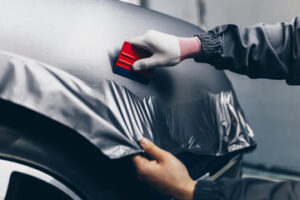Sarasota Wraps offer an incredible array of color, pattern, and aesthetic options. You can even find wraps that mimic other materials, such as carbon fiber or chrome.

To apply a wrap, the vehicle must be thoroughly cleaned and prepared. The fitters will likely remove the side mirrors, door handles, grille, and possibly the front and rear bumpers.
Car wraps are much easier to install than a paint job, and require less downtime. In addition, they are more versatile, and can be used to add graphics and logos for advertising purposes. Car wraps also offer protection from the elements and can help to maintain a vehicle’s value. However, they can’t last forever and will eventually fade, so it’s important to care for your wrap properly.
The best way to care for your car wrap is to wash it regularly using a mild detergent and non-abrasive sponge or cloth. You should also use a vinyl protectant, like STEK’s vinyl cleaner. The protectant will add a layer of protection to the wrap, and prevent color fading and shine loss.
Always use a professional installer to ensure your wrap is applied correctly. They will have the tools and experience to apply a car wrap quickly, without damage, and with a great result. They will also know the correct products to use, such as isopropyl alcohol and Primer 94. Lastly, they will know how to handle the material, so that it isn’t too hot or too cold when cutting and applying.
When applying a car wrap, start with the smallest panel you can and work your way up. This will give you the most experience and build your confidence. Once you’re confident, move on to bigger sections. Also, make sure to order a little bit extra, as it’s inevitable that you will mess up one section.
To care for your wrap, wash it immediately after a spill or dirt build-up. This will prevent the dirt from staining or damaging the finish. If your wrap starts to lose its color, apply a Teflon or silicone based polish. You should also avoid going to automatic car washes, as their brushes can scratch the surface of your wrap.
A good car wrap will last for about seven years if you take proper care of it. However, if you neglect to maintain it, it will fade or even peel. To prolong the life of your wrap, it’s best to park it undercover or in the shade as often as possible. This will protect it from fading, bird or bat droppings, and tree sap.
Durable
Car wraps are much more durable than paint and are resistant to scratches, fading, and chips. They also allow you to change your vehicle’s appearance without the expense of a new paint job. However, wrapping your car requires significant preparation and can be a time-consuming project. During the installation process, car wrap fitters will have to clean and dismantle your car, including removing door handles, mirrors, grilles, and other components. They will also work with sharp tools and must be careful not to scratch or damage the vehicle.
The lifespan of a wrap depends on how well it is maintained. Washing it regularly and avoiding harsh chemicals or abrasive materials will help to prolong its life. Also, parking your car in a garage or covered area will protect it from the sun and other weather conditions.
In addition, you should keep in mind that wrapping isn’t a replacement for a bad or damaged paint job. If the paint is chipped or rusty, it will show through the wrap and will not adhere well. Similarly, if your vehicle has existing scratches or dings, they will stick out like sore thumbs underneath the vinyl.
Aside from these factors, the intended use of your vehicle and driving habits will influence how long your wrap lasts. For example, a car that is driven for off-roading or in rough terrain will have to deal with more debris and abrasions than a car used for daily commuting.
Wraps can also be damaged by chemical exposure, such as industrial fallout and environmental pollutants. To prevent this, you should avoid parking your car near factories or chemical plants and clean off any contaminants as soon as possible. It is also a good idea to park your vehicle in a garage or covered area when not in use.
If you are planning on a more permanent transformation, it is important to keep in mind that your car wrap can be removed at any time. Although removing a wrap isn’t easy, it can be done with the right tools and patience. To avoid damaging the underlying paint, it is recommended to wash your car thoroughly with water and mild soap before attempting to remove the wrap.
Removable
Car wraps are an alternative to painting your vehicle’s body. They protect your vehicle’s original paint from weather, bird droppings, road salt and other corrosive elements. When professionally installed and maintained, a wrap can last up to five years. Unlike clear bra, a wrap doesn’t interfere with your car’s factory paint finish or devalue your vehicle in the short term.
To maintain a high-quality wrap, it’s important to wash your vehicle regularly. This will keep dirt, grime and other debris from accumulating underneath the wrap, which can lead to creases and rips. You should use a non-abrasive detergent with cold water. Always test a small, out-of-the-way area of the wrap before using a cleaner designed specifically for car wraps or an automotive soap. Make sure to rinse the soap from the wrap thoroughly after washing.
If you notice a stain or spill, you should clean it as soon as possible. Stains should be wiped away with a damp cloth before they have a chance to dry on the surface. Leaving hardened stains, like tree sap or bug splatter, on the wrap can cause damage when you attempt to remove them. If a stain is particularly difficult, you can try soaking the affected area in hot soapy water or diluting rubbing alcohol (one part alcohol, two parts water) before attempting to wipe it off.
It’s a good idea to store your wrapped vehicle in a garage or other protected location to help it last longer. Also, avoid parking it under trees that drop sap or branches that can scratch the wrap. It’s a good idea to wash your vehicle and wrap frequently, at least once every week.
If you live in a warm climate, you may need to wash your car wrap more often. High temperatures and baking sun can degrade vinyl. Ideally, you should park your wrapped vehicle in a garage or under a roof.
Affordable
Car wraps are an affordable and effective way to customize your vehicle. They can be applied to any vehicle and are available in a wide range of colors, finishes, and textures. They can also be printed with a variety of graphics and designs, including custom decals and logos. In addition, they are durable and can be easily removed when necessary. Moreover, they can protect your car’s original paint from damage caused by UV radiation and contaminants such as bird droppings and industrial fallout.
One of the biggest misconceptions regarding car wraps is that they are expensive to install. In fact, car wraps can be much more affordable than painting a car. This is because a car wrap can be applied quickly and easily, allowing you to get the look that you want without spending a fortune. In addition, car wraps are more durable than paint, which means they will last longer.
Another advantage of car wraps is that they can be installed on a vehicle in its current state. In contrast, a paint job requires the vehicle to be dismantled, which can take hours or days. This can be difficult for the average person, and it can result in scratches or dents to your vehicle’s surface. Additionally, a paint job is a labor-intensive task that can be extremely messy.
Another reason why car wraps are affordable is that they can be applied by a professional for less money than a full body paint job. However, it is important to find a qualified and experienced installer who offers competitive prices. By seeking recommendations, reading reviews, and examining previous projects, you can find a skilled wrap provider who will provide you with affordable options without compromising on quality or professionalism. It is also essential to keep in mind that car wraps must be maintained properly to extend their lifespan. It is recommended to wax your car twice a year to maintain the appearance and protect the vinyl from damage. Additionally, avoiding parking your vehicle under trees that drop sap can help extend the life of the wrap.
